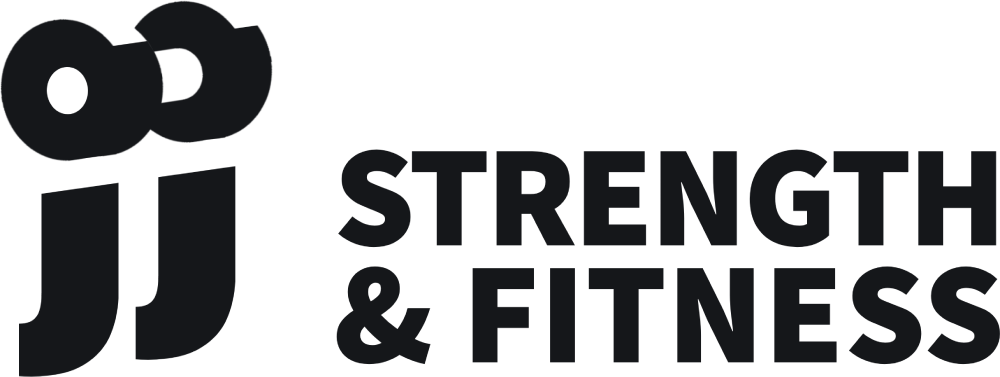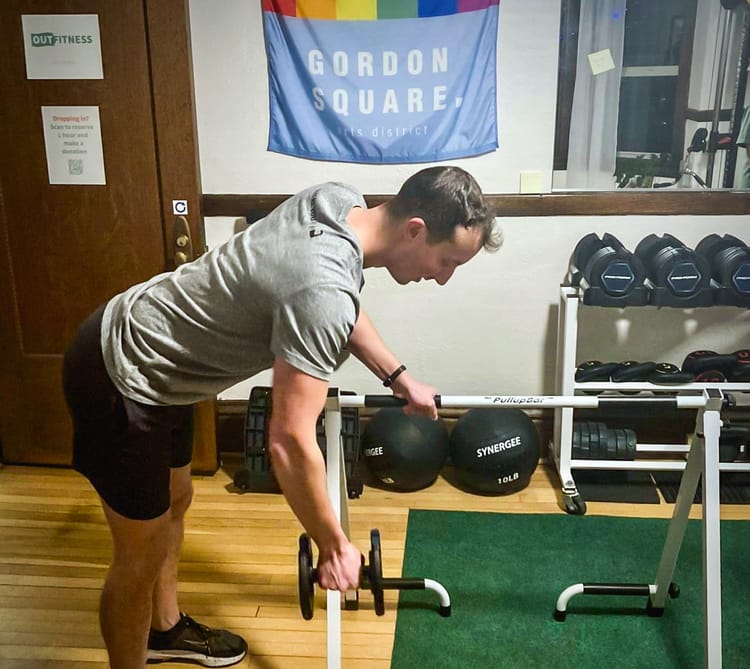Guide for building beginner strength workouts
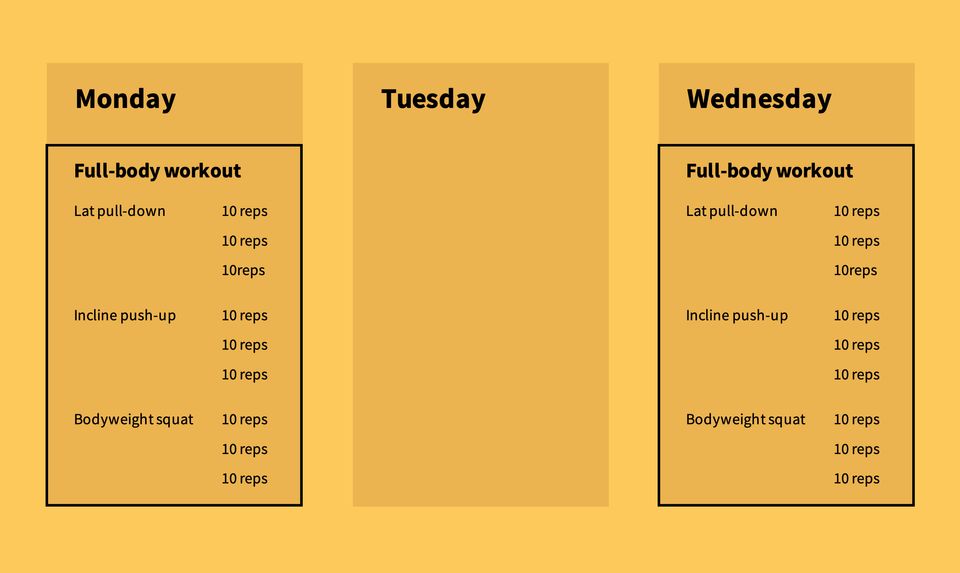
It's the most common and consequential Google search most people make to start strength training: "workout plan for beginners." The results are dizzying, full of jargon and strangers' opinions.
I wish I'd found clear, direct, and safe instructions when I started trying strength workouts in 2016. Instead, I had to bounce between many (often contradictory) sources while figuring out what worked for me, alone in my community center gym.
Now, with my experience and some studying, I've helped a dozen clients start strength training. I developed an approach that is easy for most people to understand and implement!
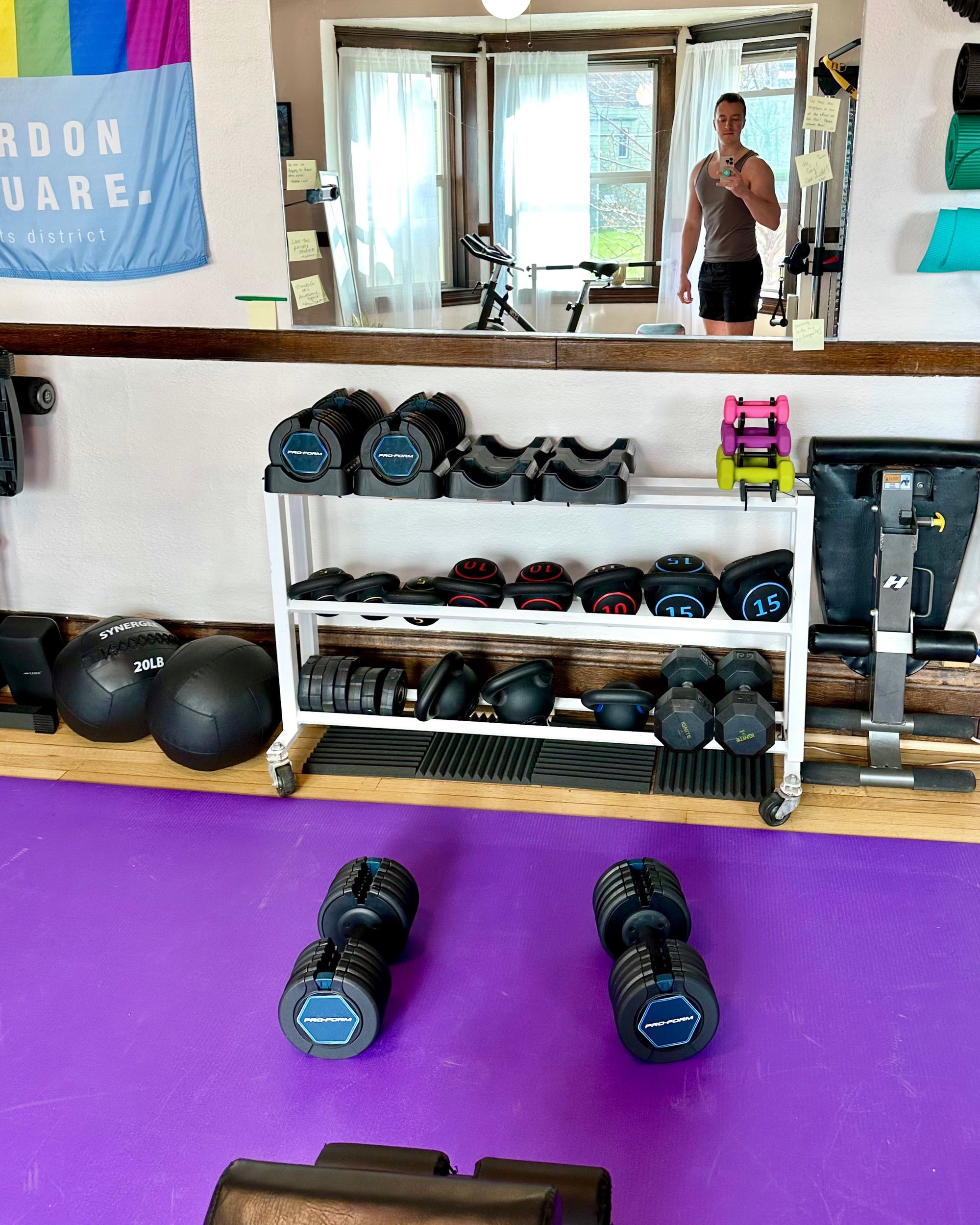
Here's what sets my approach apart:
- An emphasis on rest and caution to avoid injury, since early injuries will disrupt your morale and hinder your progress
- Simplification of dozens of exercise categories into 3 simple movement patterns – PUSH, PULL, and SQUAT
- Starting with compound exercises, which stimulate many muscles in fewer movements, resulting in shorter and more efficient workouts
This guide has plenty of explanations behind my approach and relies on the NSCA Essentials of Personal Training textbook. And there's a nice, downloadable surprise for you if you read the whole guide!
Strength training as the goal
This guide is focused on the goal of increasing physical strength and muscle growth through resistance training.
This is a beginner guide and is not intended for powerlifting, Olympic lifting, speed training, CrossFit, or plyometrics.
My guide remains mostly agnostic about equipment, though an assumption is made that beginners will need lower levels of resistance than more experienced lifters. Equipment referenced includes benches, dumbbells, kettlebells, and cable machines, which are found in many entry-level or home gyms. Bodyweight exercises are included, but this guide is not tailored for bodyweight-only workouts or calisthenics.
This guide is focused on creating strength workouts. It does not cover cardio/aerobic workouts and their interactions with strength training. Please be conservative when beginning strength training and combining it with cardio training, and allow plenty of rest between all workouts.
Rules
First, a few important rules before trying any new workout:
- Be sure your doctor agrees that you are healthy enough for strength training.
- Eat a snack (like fruit) or light meal and drink water about 1-2 hours before your workout. During your workout, take frequent sips of water.
- If at any point during exercising you experience light-headedness, dizziness, strong pain, difficulty breathing, or chest discomfort, stop immediately and rest.
Structures
Strength gains require structure. Structure is the difference between strength training and just "working out" and getting sweaty.
The hierarchy of structure for strength training, in descending order, includes: weeks, workouts, exercises, and sets.

If structure is the scaffolding for strength training, here is how I recommend building upon it.
- Weekly structure: 2-4 workouts of 30-50 minutes each per week, with rest days between
- Workout structure: 3-6 exercises in each workout, preceeded by warm-up and followed by cool-down
- Exercise structure: 3 sets of repetitions for each exercise, with rest after each set
- Set structure: about 8-12 repetitions of the movement in each set
Within a set you can see that the smallest building block of strength training structure is the repetition. When you are working your body with an exercise, you will repeat a specific movement; those repeated movements are "reps." Most studies show muscle growth is efficiently stimulated within an average range (but not fixed range) of 8-12 reps per set. And over the course of your strength training, you will accumulate thousands and thousands of repetitions.
Some additional structure, unnecessary for most beginners
There is a larger, macro-level structure, often called a program, which is made of a series of weeks. In my opinion, most beginners do not need to worry about a program structure, as you are likely still in an experimental learning phase. You'll be making changes to your training too frequently to follow the typical program length of 8-10 identical weeks. But it is smart and useful to set a reminder for yourself 8 weeks after your first workout to reflect on what's working (or not) and what you're enjoying (or not)!
There is also a concept of adding variation among your weeks (i.e. within programs), called periodization. Periods with differences in training can provide small degrees of additional strength and muscle gains, but it's an unnecessary complication for a beginner. While you're learning from your new experiences, you'll already be making changes every couple weeks: changing workouts routines with exercises you like/dislike, adjusting your weekly schedule, dealing with your energy levels and life obligations.
Let's explore my recommendations for weeks, workouts, and exercises in more detail.
Weeks
Since most people plan their work, errands, and activities by the week, it makes sense to plan workouts that way, too. Just keep in mind that strength is gained over the course of many weeks – typically 4-8 weeks for the earliest results and a year for substantial change.
I recommend 2-4 workouts of 30-50 minutes each per week, with rest days in between. If you're unsure, start with two 30-minute workouts per week!
Some people like to adopt a consistent schedule: I will work out 3 times every week – on Monday, Wednesday, and Friday at 5:30pm.
Some people (like me) use more flexible schedules: I will work out 4 mornings every week, but when I am too busy/tired, 3 times is fine. The day of the week doesn't matter, but I'll always include rest days.
Rest days are essential. Rest, not exercise, is when muscle growth actually happens! Always take a rest day in between workouts with exercises from the same movement pattern category. In other words, please avoid PUSHING two days in a row, PULLING two days in a row, or SQUATTING two days in a row – until you understand how quickly your body recovers from these exercises. (More details below in the Exercises section). A rest day can include moderate activity, like walking or cleaning, but you should avoid vigorous activity. And be sure to get a full night's sleep!
The workout routines within your weeks can be full-body workouts, which include exercises from all 3 categories of PUSH, PULL, and SQUAT; or split workouts, which split the 3 categories for 1 or 2 per workout. Let's look at how to build those workout routines.
Workouts
A beginner workout routine of 30-50 minutes should include a warm-up, 3-6 strength exercises, and a cool-down. (Most strength workouts longer than an hour will create fatigue that reduces the benefits, degrades your exercise form, and puts you at additional risk of injury).
A warm-up should include 3-10 minutes of both light cardio (easy, repetitive movements like brisk walking, jumping jacks, cycling, or rowing) and dynamic stretches (stretching with continuous motion). You should feel physically warmer afterward, perhaps breaking a light sweat, but not out of breath. The increase in body temperature loosens up your muscles and joints and helps prevent injury.

You can also search YouTube for guided warm-ups with dynamic stretching.
Your workout's 3-6 exercises will be strength exercises from 3 movement pattern categories: PUSH, PULL, and/or SQUAT. You will select exercises from all 3 categories to build a full-body workout routine, or you will select exercises from separate categories to build 2 or 3 split workout routines. Remember, schedule a rest day in between any workouts using the same movement pattern category.
Lastly, always end your workout with about 2-5 minutes of cool-down. If your heart rate or breathing rate feel rapid, or if you're hot or sweaty, you want to lower your body temperature gradually, not abruptly. You can do so with slow walking or cycling for a few minutes. Then, once you're feeling more comfortable, complete some static stretches, the typical sort of stretching with holds, 10-60 seconds each or until you feel muscle and joint tension lessening. Please always stretch after exercising!
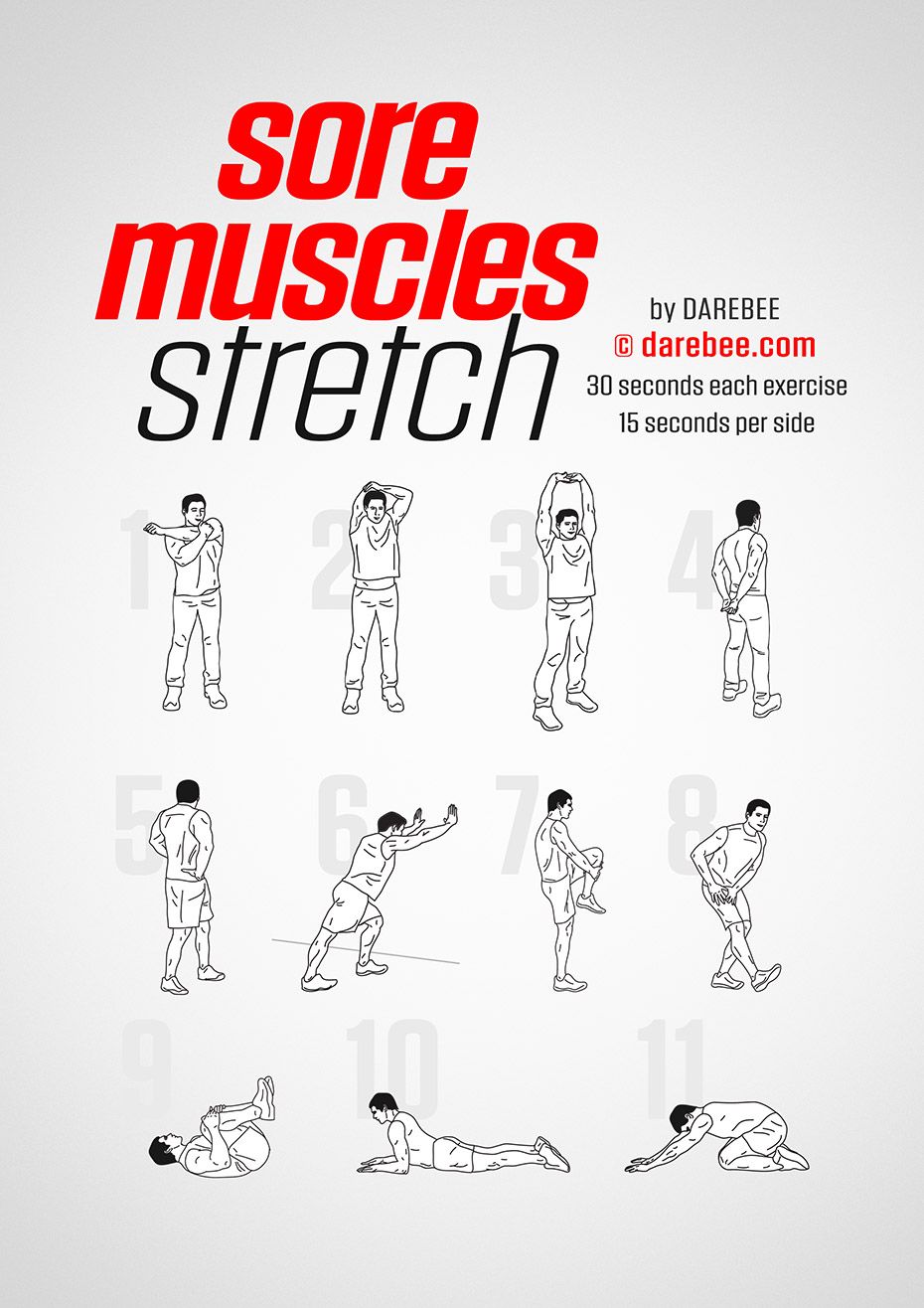
You can also search YouTube for guided cool-downs with static stretching.
Typically, you will follow the same routine(s) each week, but you can alter or swap the exercises in your routines until you find what's most comfortable, enjoyable, and convenient for you. And if you find you don't enjoy full-body workouts, you can switch to split workouts, or vice versa.
Now let's get into the most exciting part: those strength exercises.
Exercises
For strength training, we know we want 3-6 compound exercises, sandwiched between our warm-up and cool-down, in each routine. You'll also rest briefly after every set of every exercise.
I have simplified many kinds of strength exercises into categories based on 3 movement patterns – PUSH, PULL, and SQUAT. These are based on real-life movements:
Common PUSH strength exercises using typical equipment are: push-ups, dumbbell bench press, incline dumbbell bench press, machine chest press, and dumbbell shoulder press.
Common PULL strength exercises using typical equipment are: single-arm dumbbell rows, seated cable rows, pull-ups, and lat pull-downs.
Common SQUAT strength exercises using typical equipment are: bodyweight squats, dumbbell/kettlebell squats, box step-ups, and dumbbell lunges.
Yes, there are some additional movement patterns.
Other movement patterns are slightly more advanced and will benefit from building up some foundational strength first, to avoid strain or injury.
For example, you can HINGE at the hips, like in a deadlift. Or you can ROTATE the torso, like in a wood chop exercise. Since many people are susceptible to lower back pain, I find it better to build strength with PUSH, PULL, and SQUAT initially.
And what about abs? Abdominal exercises have received inordinate amounts of marketing over many decades. Thankfully, these compound exercises already require core activation – either stabilizing your torso or contracting your abdomen or lower back. Therefore, they will stimulate and increase your core strength, and you won't need extra exercises that isolate your abs. Besides, "six-pack abs" require very low body fat levels for appearance, and you can’t lose body fat in any one specific area of your body, no matter how many sit-ups or crunches you do.
In my example exercises from the PUSH, PULL, SQUAT categories, I've recommended compound exercises, because they work multiple muscle groups at the same time. For example, a lat pull-down will activate your back, rear shoulder, and bicep muscles as you pull, plus your core (abdomen and low back) will work to stabilize your torso. Contrast that with an isolation exercise like dumbbell curls, which primarily works only your biceps. (That being said, if you find isolation exercises you enjoy, include them! Just put them at the end of your workout routine, since they require less concerted energy.)

Compound exercises require you to learn proper form, or the proper body alignment and motion paths for the exercise's mechanics. Form instructions should include images, video, and/or text for each exercise. A trainer can help you assess your form during an exercise, but self-monitoring your form is always important, too. Use a mirror to watch your movement, and pay attention to your physical sensations at the same time. When completed with good form, compound exercises stimulate many muscles with fewer repetitions, resulting in shorter and more efficient workouts!
"Where do I feel this?"
Exercising with good form requires a kind of mindfulness as you frequently ask yourself, "Where in my body do I feel this exercise?" Observe where you feel muscle activation, contraction, or warmth.
For example, a machine row is meant to work your back muscles, so ask yourself while performing, "Do I feel my back muscles squeezing to pull the handle and then slowly releasing to return it?" If you feel (or even see) strain in your neck muscles, instead...your form is incorrect.
Detecting these sensations will take some practice, but it's an invaluable skill. Once you're in tune with these feelings, then the next time you pick up a heavy box, you'll be able to feel if you're lifting it with your legs and not your back!
Compound exercises are safe for beginners when using low volume while learning the proper form. Volume = number of reps x amount of resistance.
- You change the number of reps by completing the movement more or fewer times.
- You change the amount of resistance by adding/removing weights (or by changing your body's orientation to gravity).
First, choose a resistance level that makes you feel, "This amount of weight feels manageable and under my full control, and I can complete the movement at least 12 times." Picking this resistance level requires some guesswork, so always begin with lighter weight to be safe!
Second, visualize good form for the exercise, and begin your repetitions (in front of a mirror, if possible). STOP when you feel, "I can only do 2 more reps with proper form," even if you don't reach 12. This is called keeping reps in reserve, and, unlike training to failure, helps you avoid injury from straining during an incomplete rep.
It is better to stop repetitions before you cannot continue, rather than continue with increasingly poor form. And you should decrease the resistance next time if it was too heavy for your desired number of reps.
I recommend 3 sets of about 8-12 repetitions for each exercise, with rest after each set. Studies show doing more than one set is best for maximizing stimulation, yet there are diminishing returns from adding lots more sets (with the numbers varying between people). I like my sets in groups of 3! The first set (re)acquaints my mind and body with the movement while I practice good form. The second set lets me work the muscles confidently. And the third set is typically when I try any increase in volume.
If you've learned the exercise form and chosen the proper amount of resistance, each set should feel like it required real effort without being exhausting. On a scale of 1 to 10, with 10 being the totally tiring, each set should be a 6 or 7 or 8. That's subjective, but your feelings of exertion are the best way to check for the right volume, so long as your form stays good! Always decrease the resistance or reps if a set feels too intense. (Learn more in my reps explainer.)
Together, resistance and reps allow you to adjust the exercise's volume. Gradually increasing volume over time is the key to progressive overload. (More on that in the next section.)
Unlike cardio exercise, which is usually continuous, strength exercise alternates between periods of work and periods of rest. I recommend 60 seconds of rest after each set. You should rest longer or shorter as needed so that you feel ready to take on the next set. If your heart is racing after a set, rest until you feel comfortable again.
If you're short on time...
...you can instantly shorten a workout routine on a busy day by adjusting each exercise to 2 sets instead of 3 sets. You'll still get most of the benefit of the full workout routine. Doing fewer sets is smarter and safer than skipping your rest periods after sets!
Now let's build a simple, full-body workout routine with compound exercises from each of our 3 categories. Let's choose incline dumbbell press for PUSH, single-arm dumbbell rows for PULL, and bodyweight squats for SQUAT. (Besides preferring compound exercises, you can also choose based on your familiarity with the movements, your personal preferences, and/or the equipment available.)
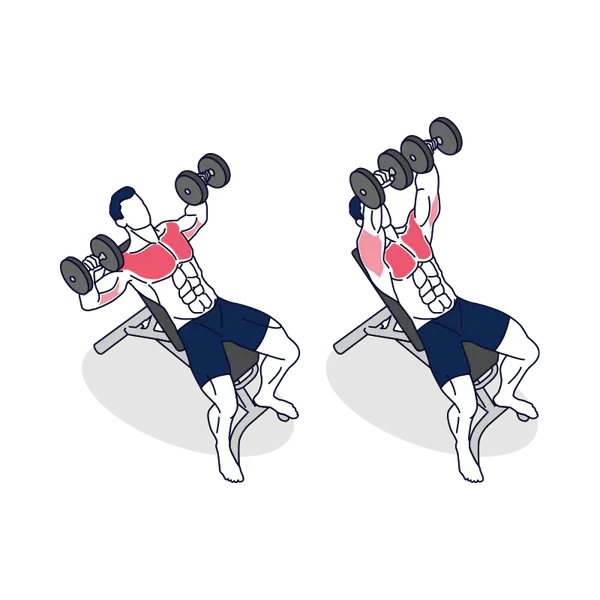
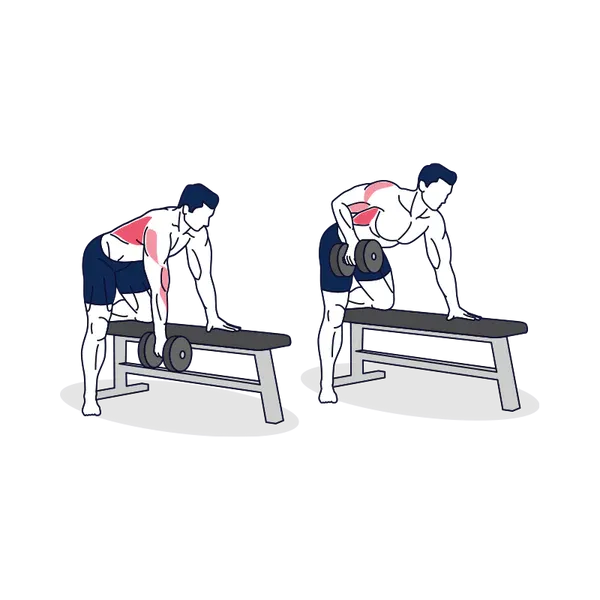

Incline dumbbell press, single-arm dumbbell row, bodyweight squat
So our full-body workout routine will start with a warm-up, continue through 3 sets of 8-12 reps for each of the 3 exercises (with rests), and then conclude with a cool-down. That routine will probably take about 30 minutes. Here's what it looks like in an app. (My app suggestion is this guide's final section.)

You could easily create similar routines for split workouts, instead. You just need 3 separate routines, one with 3 PUSH exercises, one with 3 PULL exercises, and one with 3 SQUAT exercises!
It bears repeating a third time: Always take a rest day in between workouts using one or more of the same movement pattern category.
Progressive overload
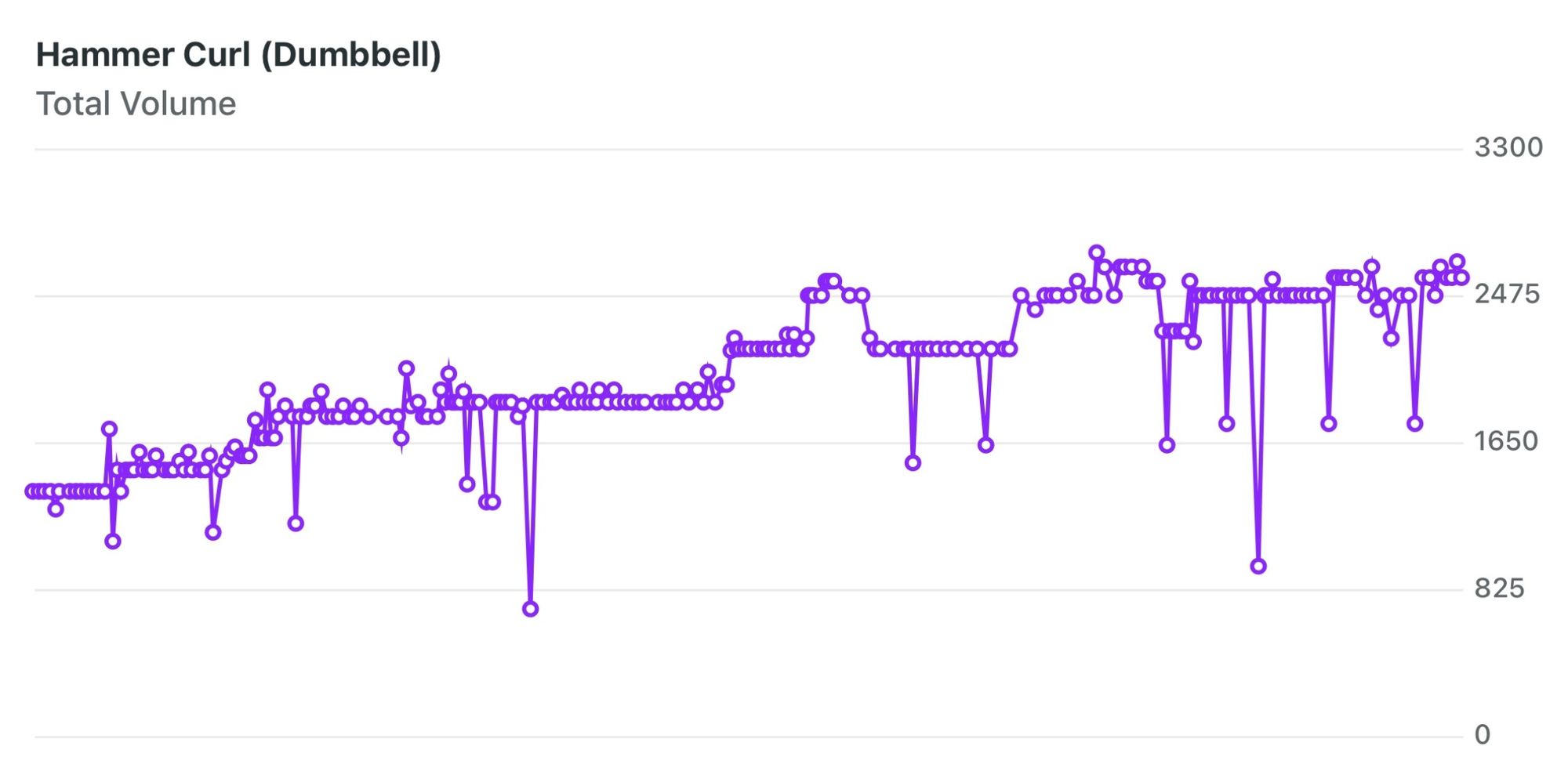
Within 8 weeks of strength training, you should notice some increase in your strength. "Hey, doing 12 reps of that feels easier now!"
- Your initial gains are primarily due to neuromuscular adaptations. As you learn the exercise and its proper form, your brain and nervous system get better at coordinating muscle fiber contraction and release at the correct times and correct speeds for each motion.
- Once you and your body are familiar with an exercise after several workouts, your additional strength gains will come from muscular adaptations. Muscle growth and strengthening does not happen accidentally. It requires consistent workouts – with progressive overload, as defined below – as well as proper sleep and sufficient nutrition! (All these factors are why no one grows huge muscles accidentally – even though some feminine stereotypes cause a fear of quickly becoming "too bulky.")
Progressive overload is your manipulation of your workouts' volume, duration, and frequency to stimulate continual muscle adaptations. After you've structured your workouts' usual durations (30-50 minutes) and frequency (2-4 times weekly), then volume (reps x resistance) becomes your primary variable for progression. You gotta keep lifting more volume to grow more muscle.
For the safest volume adjustment for progressive overloading, I recommend the 2-for-2 rule.
For example, on Monday you planned to complete your lat pull-down with 3 sets of 12 reps x 50lbs of resistance on the weight stack.
- On your third set, you easily continued for a total of 14 reps (still stopping when you felt you had 2 reps in reserve). Then on Wednesday, the exact same thing happened!
- Next time you have the lat pull-down in your workout, you will attempt that third set with 10% more resistance (+5lbs).
- If you consistently achieve 12 reps with 55lbs in that third set, try going for at least 14 x 50lbs in the second set, too. Once the 2-for-2 rule bumps your second set to 55lbs, too, try for extra reps in the first set, and so on.
Now, a 10% increase in resistance is not always simple with your equipment... For example, if you did 12 reps of shoulder presses with 10-pound dumbbells, and the next larger dumbbells are 15-pound, that would mean a 50% increase! When equipment increments will increase resistance by more than 10%, plan to attempt fewer reps. So if your new set of shoulder presses calls for 15-pound dumbbells, shoot for 8 good reps with them. With time, you will be able to complete 9 reps with the 15-pound dumbbells, which is about a 10% increase in total volume compared to your original 12 x 10lbs.
This is when the flexibility of that 8-12 rep range comes in handy. Each time you increase the resistance amount, you will likely decrease reps closer to 8. As you eventually adapt to that resistance, your completed reps will increase back towards 12 (and then to 13, 14, or more). But if you cannot get close to 8 reps (at least 6 reps with good form), you need to decrease the resistance amount.
The 2-for-2 rule keeps me increasing my exercise volume safely while progressing, while staying in tune with my body's seasons of wellness or recovery. Plus, I love competing with my past self to set new personal records.
But, as you might have noticed, you'll have to keep track of a lot of numbers! For every exercise, you'll want to record your sets, reps, and resistance amounts. Then you'll need to look at your previous workout's numbers during your subsequent workouts, in order to check for 2-for-2 rule opportunities. This is why I strongly recommend an app to keep track of it all.
Keeping track of it all
You've built a strength training plan, with repetitions of exercises bundled into sets, which are sequenced inside workout routines, which are scheduled across weeks. Great work! That's more planning than most people dedicate to their training, which means you'll experience better results than most people.
To keep track of those reps, sets, exercises, and workouts, you need a workout log. Workout logs originally were written on paper, and if you like paper, bring a small notebook and pencil to your gym. I believe the better option today, to keep and compare all your training data, is an app.
- When you join my fitness coaching, my JJ Strength app includes your customized workout log. You can also search your app store for "workout log."
- My top recommendation, however, is the Strong app, and they don't pay me to say it. It's one of my favorite "apps that actually work."
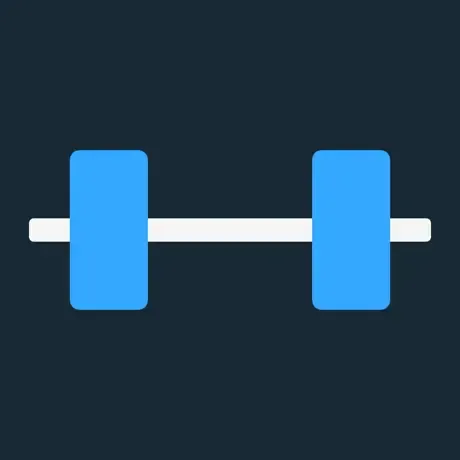
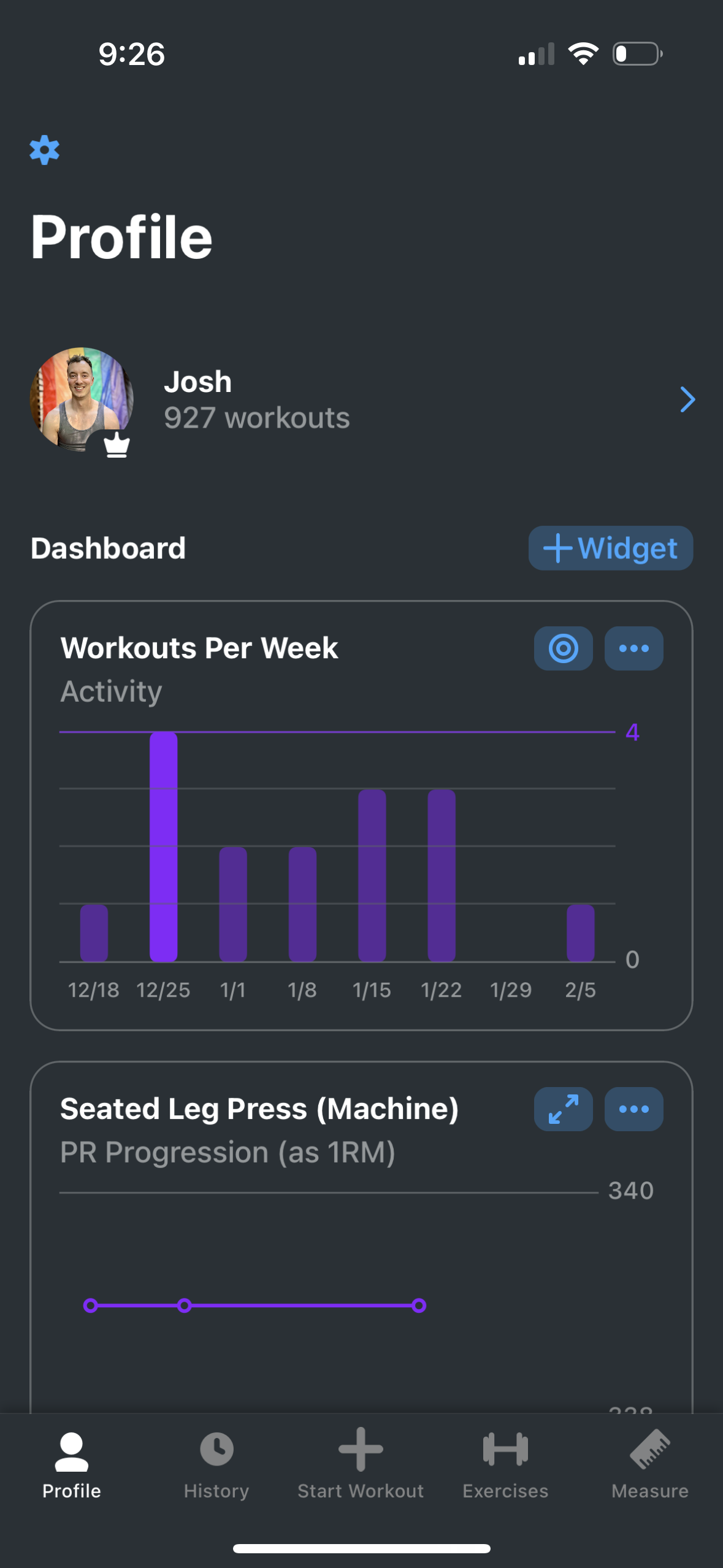
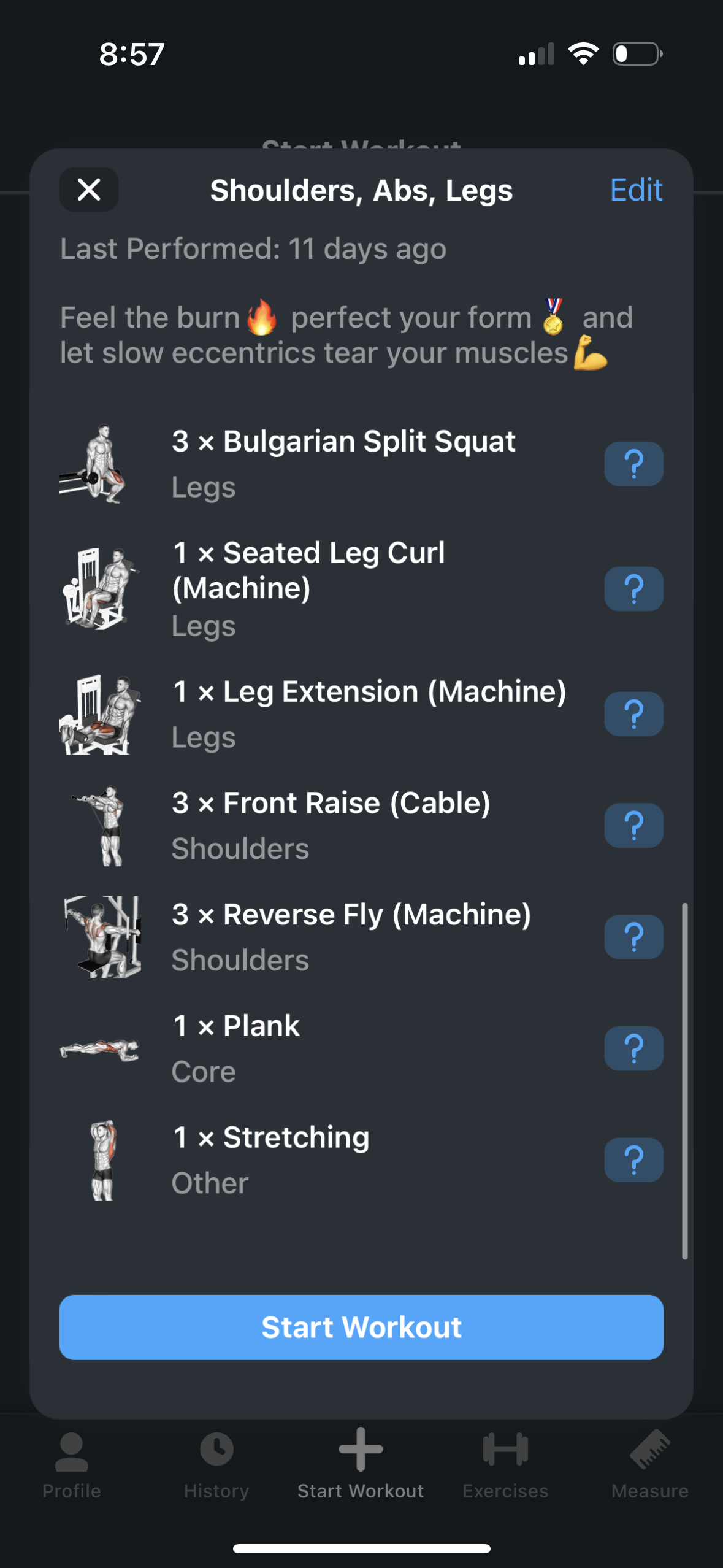
Strong is a no-nonsense way to build and follow your workout routines, step-by-step. I always know my next move at the gym with this app. It includes automatic rest timers after sets, and you can open exercise instructions for proper form. It also shows your previous volume (reps x resistance) for each exercise during your current workout! That makes using the 2-for-2 rule for progressive overload much easier.
Srong is FREE to use for unlimited logging and building up to 3 workout routines.

And since you made it to the end of this guide, I have a reward for you. After you download Strong, you can load up these sample, split workout routines that I've created with compound movements. (The routines require a cable machine, bench, and dumbbells.)
Remember to start these new exercises with low volume, and follow the "Rules" at the top of this guide. Then, over the course of several weeks, edit these routines according to your experiences and make them your own!
Interested in intermediate strength training and beyond? Check out this complete guide at Stronger by Science.
